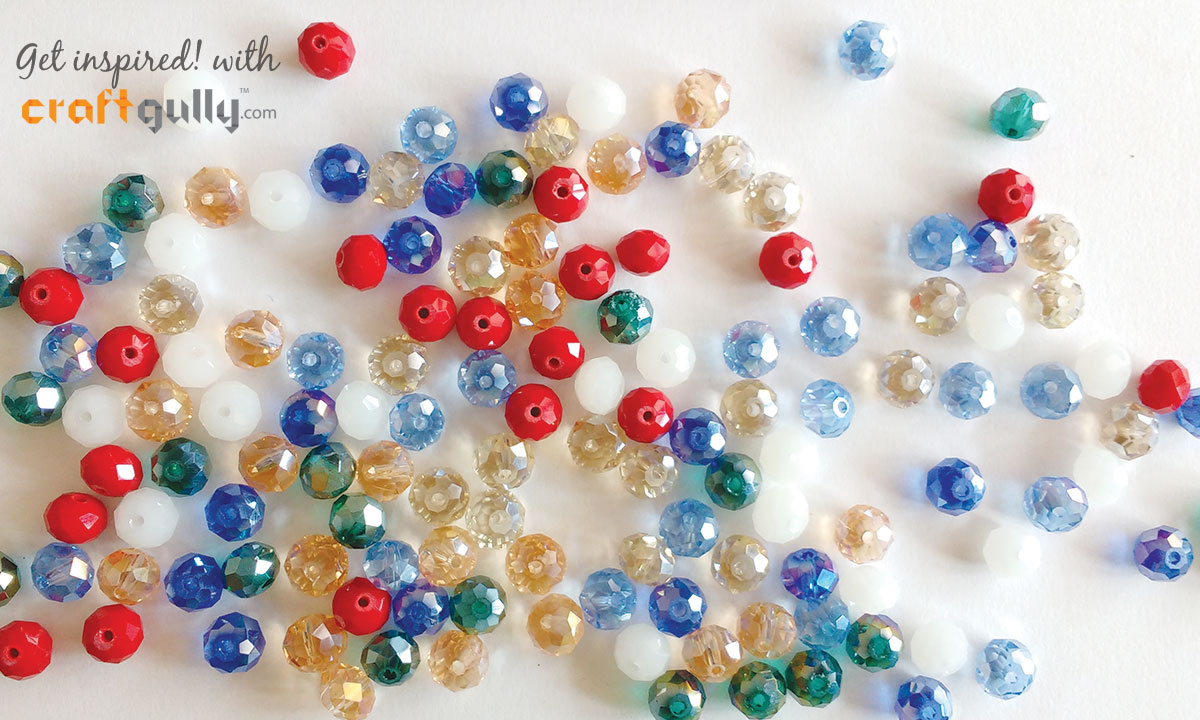Jewellery Making Terms and Tools

Essentials for Making Earrings
1. Earring Backs: Earring backs are the most common form of locks used for studs or posts. These are bullet or barrel-shaped and get locked with a slight push and friction. Some even come with a clear back.
2. Earring Studs: Earring studs, also known as earring posts, have a concave base, which holds the bead or stud in place.
3. Earring Clasps: Clasps act as a lock to secure the earring on the ear. Some clasps come with a base to stick the stud or quilled design onto it, and some have a rhinestone or other embellishment stuck on them.
4. Eye Pins: Eye pins are used for holding up beads in a long earring. You can also use them as links for making rosaries, danglers, and other beaded charms.
5. Hooks: Hooks serve as a back for the earrings. Some hooks, like the French hook and loops, work best when you wish to add length to the earring. These are often used for creating danglers.
6. Hoops: Earring hoops are round and enable you to string on the beads quite easily. Hoops are available with different types of locking systems, such as a crimp lock, lever back lock and more.
7. Head Pins: Head pins are mostly used for creating long earrings, with beads strung on one side and the wire wound at the other end. You can also use these for making charms.
8. Ball Pins: These are head pins with a tiny ball at the end. These are useful for making dangles and charms, and the ball also adds to the design of the jewellery.
Essentials for Making Bracelets and Necklaces
1. Box Clasp: Box clasps are made with two pieces, one which opens on pushing the jutted end and pressing it to pull it out and another, which clicks into place on pushing. Box clasps are available in a variety of shapes, sizes and designs.
2. Crimp Ends: Crimp ends help you close the ends of your piece of jewellery. Crimp beads and crimp tubes are highly used and are easily available. These hold the stringing material, so you can fold and tighten it with a pair of plier. Crimp Ends are also available in round shape, clamshell design and with loops.
3. Elastic Wire: Elastic wire is used as a thread to hold the beads of your piece of jewellery. It is often preferred for making bracelets and anklets.
4. Guardian Wires: Guardian wires help you tighten the ends of a bracelet or a neckpiece. These lend a professional look to your pieces of jewellery.
5. Jewellery Wire: This is a coloured, aluminium wire, which is quite versatile and great for making jewellery. You can also opt for a stiffer copper wire for making sturdy pieces of jewellery.
6. Lobster Claw Clasps: Lobster claw clasps are ideal for use with bracelets and necklaces. Each piece is spring-loaded, which enables it to open and close easily.
7. Nylon Thread: Nylon threads are commonly used for making jewellery. It doesn’t fray and its ends don’t wear out, so it proves to be durable.
8. Prong Clasp: A prong clasp is also known as pinch bail or ice-pick bail. This type of a clasp is easy to attach to ear wires with beads or a pendant.
9. ‘S’ Clasp: S-shaped clasps are designed to connect with the piece of jewellery on its one end and slide through the other end. ‘S’ hooks or clasps are available in both, basic and ornate designs.
10. Screw-on Clasps: Screw-on clasps have loops at both its ends and hence are perfect for making beaded neckpieces.
11. Memory Wire: Memory wire has a stronger temper than the regular wire, so it holds its shape and retains the original shape of the bracelet or neckpiece made with it. You can choose round memory wire or flat memory wire. You can choose this wire in different sizes to make bracelets, rings, neckpieces and more.
12. Beading Board: A bead board or beading board allows you to lay out the beads as per the planned design. It also has measurements noted on its edges, so that you can determine the length of the piece you are creating. Some boards also have compartments to hold your beads and accents.
13. Jump Rings: A jump ring is a simple metal wire ring, which can be easily used as a connector or a clasp for chains, earrings and bracelets.
14. Connectors: Connectors work as joints between beads and clasps or even between two bead strings. Because these are visible they come in a variety of shapes, designs and colours with various combinations of rings attached.
Essential Tools
1. Beading Needle: A beading needle is longer than regular needles and are designed to fit most types of beads. Needles are available in various sizes, so you can choose the one that suits your requirement.
2. Flat-nose Plier: A flat-nose plier lets you bend wire or even straightening out the kinks from a wire. It is also essential to your jewellery-making kit as you can open and close jump rings and often for crimping crimp beads.
3. Round-nose Plier: A round-nose plier is also known as a rosary plier and has rounded jaws, tapering till the tip. This pair of plier is commonly used for making wrapped loops, spirals, coils, S shape and eye pins from wire.
4. Wire Cutter: A wire cutter, also known as a flush cutter, is useful in making cuts on wires, eyepins and headpins.
5. Bead Reamer: A bead reamer enables you to enlarge holes in beads. Not only that, you can also smoothen the hole. It works on glass, stone, metal and other many other types of beads.
6. Bent-nose Plier: When it comes to delicate jobs, what you need is a bent-nose plier. This tool helps you achieve a professional finish while bending wires and crimping.
7. Side-cutter Plier: Also known as a diagonal plier, a side-cutter plier are designed to cut jewellery wire. Its jaws has edges, which define the plane and intersect the rivet at an angle.
8. Box-joint Snipe Plier: This type of a plier has a long nose, which can bend, cut and re-shape the wire. Owing to its length, the plier easily reaches narrow areas on your piece of jewellery, thereby allowing you to work on intricate designs.
9. Hole Punch Plier: A hole punch plier is essentially used to create holes in embellishments, so you can add them to your piece of jewellery.
10. Chain-nose Plier: This pair of semi-round pliers has flat jaws, which taper till the tip. They enable you to bend and wrap wire to make loops and also open and close jump rings. This type of a plier makes it easy to access narrow areas of your piece of jewellery.
11. Bail-making Plier: This type of a plier is essentially used for bending wires and creating loops or connectors. You can also bend metal to make clasps and ear wires.
12. Jaw Plier: A jaw plier is designed to hold and straighten the wire in use, while you make any piece of jewellery. It is ideal for wrapping wire as it removes all kinks.
13. Crimping Plier: A crimping plier has notched jaws, which help in crimping crimp beads.
14. Chasing Hammer: A chasing hammer is versatile and can be used for chasing, peining and more. It helps you shape the metal as desired.
15. Wire Twister: This tool lets you twist multiple wires simultaneously. It might be useful when you need to attach the wires to a piece or cut them uniformly.
16. Beading Awl: An awl is most suited for bead knotting. Its fine point also helps you open seamed beads or loosening thread knots for making additions to the piece of jewellery.
17. Tweezers: Tweezers are useful in many forms of crafts, however, they are especially useful in handling jewels and other items or creating intricate jewellery designs. Straight tweezers are ideal for handling items, whereas curved tweezers are suitable for placing jewels or accents in the designated place or holding the designed piece together.
18. Jewel Picker: A jewel picker comes in handy when you have to pick up tiny items and secure them in their place. It normally has silicone tips, which sticks to the item to be carried, and lets you handle them with great care. A picker is especially useful while dealing with gems and glitter.
19. Cord Nipper: A cord nipper is used for snipping off chain or beading wire. This tool is normally angled, so it is easy for you to cut close to the tied ends.
Is there something that you thing must get added to the list? Write in a comment below and we will be sure to add it in!
Happy Crafting™!



Leave a Comment